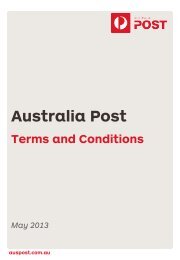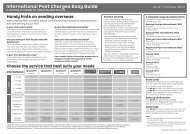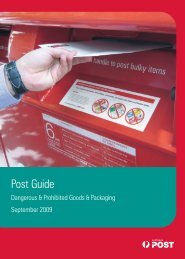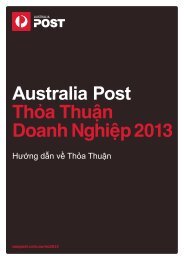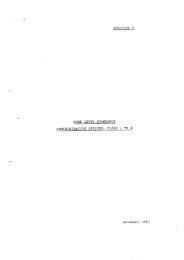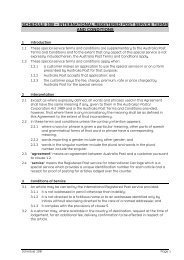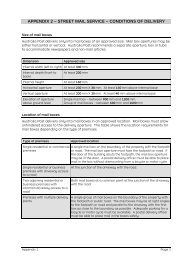Australia Post Annual Report 2008–09
Australia Post Annual Report 2008–09
Australia Post Annual Report 2008–09
Create successful ePaper yourself
Turn your PDF publications into a flip-book with our unique Google optimized e-Paper software.
Notes to and forming part of the Financial <strong>Report</strong> for the year ended 30 June 2009<br />
(c) Basis of consolidation<br />
The consolidated financial statements<br />
comprise the financial statements of the<br />
corporation and its subsidiaries (the group)<br />
as at 30 June each year. Interests in<br />
associates are equity accounted and<br />
are not part of the consolidated group.<br />
Subsidiaries are all those entities over<br />
which the group has the power to govern the<br />
financial and operating policies so as to obtain<br />
benefits from their activities. The existence<br />
and effect of potential voting rights that are<br />
currently exercisable or convertible are<br />
considered when assessing whether a<br />
group controls another entity. The financial<br />
statements of the subsidiaries are prepared<br />
for the same reporting period as the parent<br />
company, using consistent accounting policies.<br />
In preparing the consolidated financial<br />
statements, all intercompany balances and<br />
transactions, income and expenses and<br />
profit and losses resulting from intra-group<br />
transactions have been eliminated in full.<br />
Subsidiaries are fully consolidated from the<br />
date on which control is obtained by the group<br />
and cease to be consolidated from the date on<br />
which control is transferred out of the group.<br />
Investments in subsidiaries held by the<br />
corporation are accounted for at cost in the<br />
separate financial statements of the parent<br />
entity less any impairment charges.<br />
The acquisition of subsidiaries is accounted<br />
for using the purchase method of accounting.<br />
The purchase method of accounting involves<br />
allocating the cost of the business combination<br />
to the fair value of assets acquired and the<br />
liabilities and contingent liabilities assumed<br />
at the date of acquisition.<br />
Minority interests not held by the group are<br />
allocated their share of net profit after tax in the<br />
income statement and are presented within<br />
equity in the consolidated balance sheet,<br />
separately from parent shareholders’ equity.<br />
(d) Significant accounting judgements,<br />
estimates and assumptions<br />
(i) Significant accounting estimates<br />
and assumptions<br />
The preparation of the financial statements<br />
requires management to make judgements,<br />
estimates and assumptions that affect the<br />
reported amounts in the financial statements.<br />
Management continually evaluates its<br />
judgements and estimates in relation to<br />
assets, liabilities, contingent liabilities,<br />
contingent assets, revenue and expenses.<br />
Management bases its judgements and<br />
estimates on historical experience and<br />
on other various factors it believes to be<br />
62<br />
<strong>Australia</strong> <strong>Post</strong> <strong>Annual</strong> <strong>Report</strong> <strong>2008–09</strong> | Financial and statutory reports<br />
reasonable under the circumstances, the<br />
result of which forms the basis of the carrying<br />
values of assets and liabilities that are not<br />
readily apparent from other sources.<br />
Management has identified the following<br />
critical accounting policies for which significant<br />
judgements, estimates and assumptions are<br />
made. Actual results may differ from these<br />
estimates under different assumptions and<br />
conditions and may materially affect financial<br />
results or the financial position reported in<br />
future periods.<br />
Further details of the nature of these<br />
assumptions and conditions may be found in<br />
the relevant notes to the financial statements.<br />
Investment property<br />
The group obtains independent third party<br />
valuations of its investment property portfolio<br />
annually. The basis of these valuations is<br />
outlined in note 15 and includes certain<br />
significant assumptions.<br />
Impairment of jointly controlled entities,<br />
goodwill and intangible assets with<br />
indefinite useful lives<br />
The group determines whether jointly<br />
controlled entities, goodwill and intangibles<br />
with indefinite useful lives are impaired at least<br />
on an annual basis. This requires an estimation<br />
of the recoverable amount of jointly controlled<br />
entities and cash generating units, to which<br />
the goodwill and intangibles with indefinite<br />
useful lives are allocated. Recoverable amount<br />
is assessed using a value-in-use discounted<br />
cashflow methodology. The assumptions used<br />
in the estimation of recoverable amount of<br />
goodwill and intangibles with indefinite useful<br />
lives are discussed in note 16.<br />
Make-good provisions<br />
Management has made assumptions in<br />
arriving at its best estimate of the likely costs<br />
to “make good” premises that are currently<br />
occupied under operating lease. Such<br />
estimates involve management forecasting the<br />
average restoration cost per square metre and<br />
are dependent on the nature of the premises<br />
occupied. The provision recognised is<br />
periodically reviewed and updated based<br />
on the facts and circumstances available at<br />
the time. Changes to the estimated future<br />
costs are recognised in the balance sheet<br />
by adjusting both the expense or asset<br />
(if applicable) and provision. The related<br />
carrying amounts are disclosed in note 20.<br />
Employee benefits<br />
Various assumptions are required when<br />
determining the group’s superannuation,<br />
long-service leave, annual leave and workers’<br />
compensation obligations. Note 12 describes<br />
the key assumptions used in calculating the<br />
group’s superannuation obligation.<br />
Unearned postage revenue<br />
The group makes allowance for the assessed<br />
amount of revenue from postage sales as at<br />
balance date in respect of which service has<br />
not yet been provided. Actuarial valuations are<br />
obtained every three years and the provision is<br />
reassessed every six months based on factors<br />
provided by the group’s external actuaries.<br />
(ii) Significant accounting judgements<br />
Investment property classification<br />
The group has determined that those<br />
properties classified as investment properties<br />
are primarily held to earn rentals or for capital<br />
appreciation. Where a property is also used<br />
for internal use, the group has determined<br />
whether this is an insignificant portion of<br />
total floor space and, if so, classified the<br />
property as investment property.<br />
Operating lease commitments –<br />
group as lessor<br />
The group has entered into commercial<br />
property leases on its investment property<br />
portfolio. The group has determined that it<br />
retains all the significant risks and rewards of<br />
ownership of these properties and has thus<br />
classified the leases as operating leases.<br />
(e) Business combinations<br />
The purchase method of accounting is used to<br />
account for all business combinations regardless<br />
of whether equity instruments or other assets<br />
are acquired. Cost is measured as the fair<br />
value of the assets given, shares issued or<br />
liabilities incurred or assumed at the date of<br />
exchange plus costs directly attributable to<br />
the combination. Where equity instruments<br />
are issued in a business combination, the fair<br />
value of the instruments is their published<br />
market price as at the date of exchange.<br />
Transaction costs arising on the issue of equity<br />
instruments are recognised directly in equity.<br />
Except for non-current assets or disposal<br />
groups classified as held for sale (which are<br />
measured at fair value less costs to sell), all<br />
identifiable assets acquired and liabilities and<br />
contingent liabilities assumed in a business<br />
combination are measured initially at their fair<br />
values at the acquisition date. The excess of<br />
the cost of the business combination over the<br />
net fair value of the group’s share of the<br />
identifiable net assets acquired is recognised<br />
as goodwill. If the cost of acquisition is less<br />
than the group’s share of the net fair value of<br />
the identifiable net assets of the subsidiary,<br />
the difference is recognised as a gain in the<br />
income statement, but only after a<br />
reassessment of the identification and<br />
measurement of the net assets acquired.




